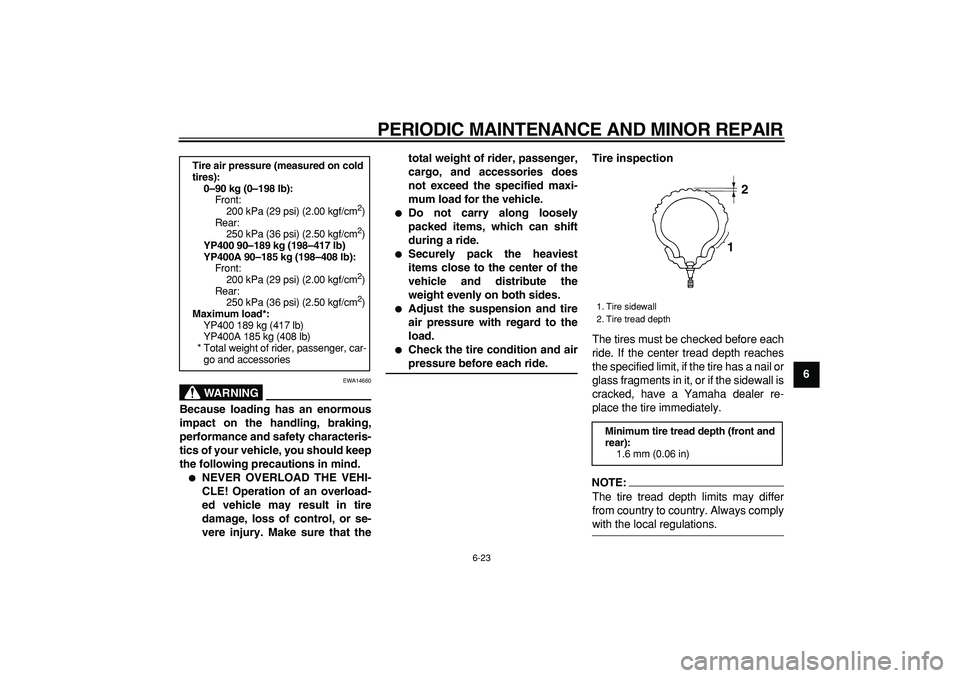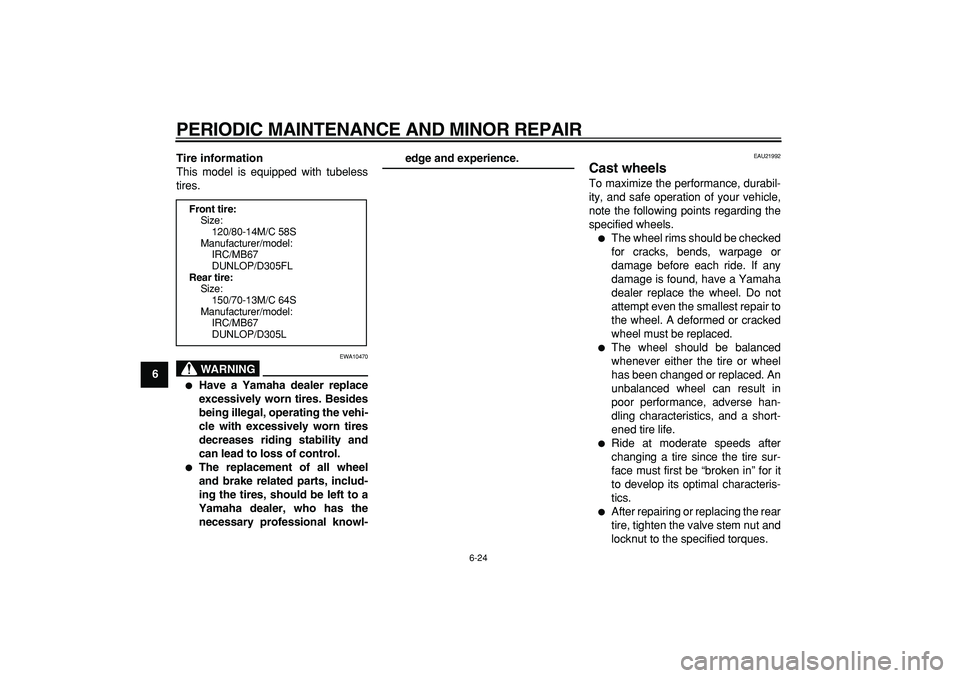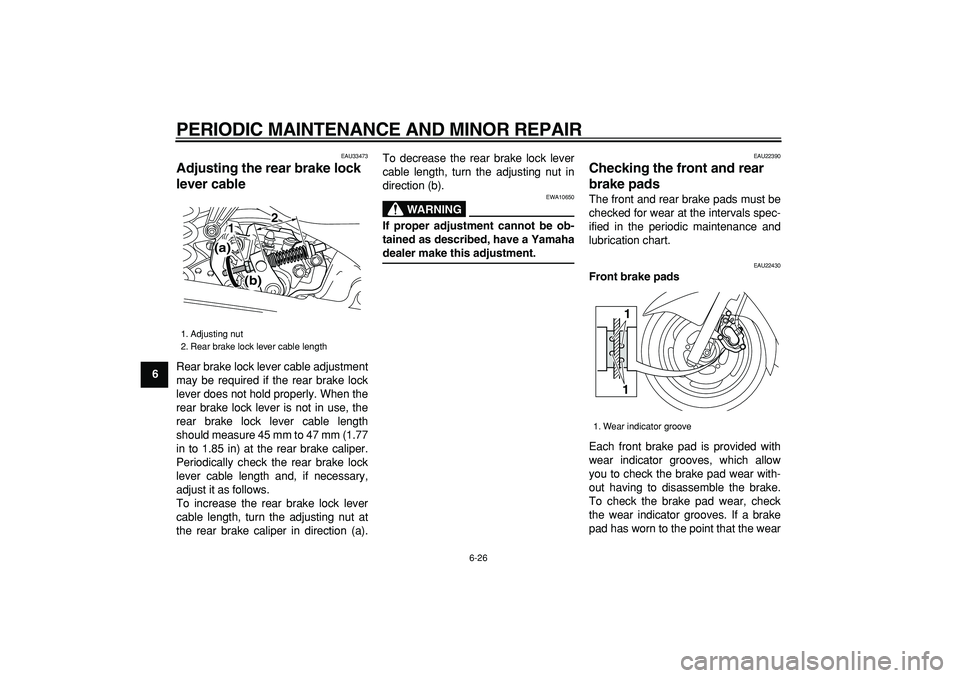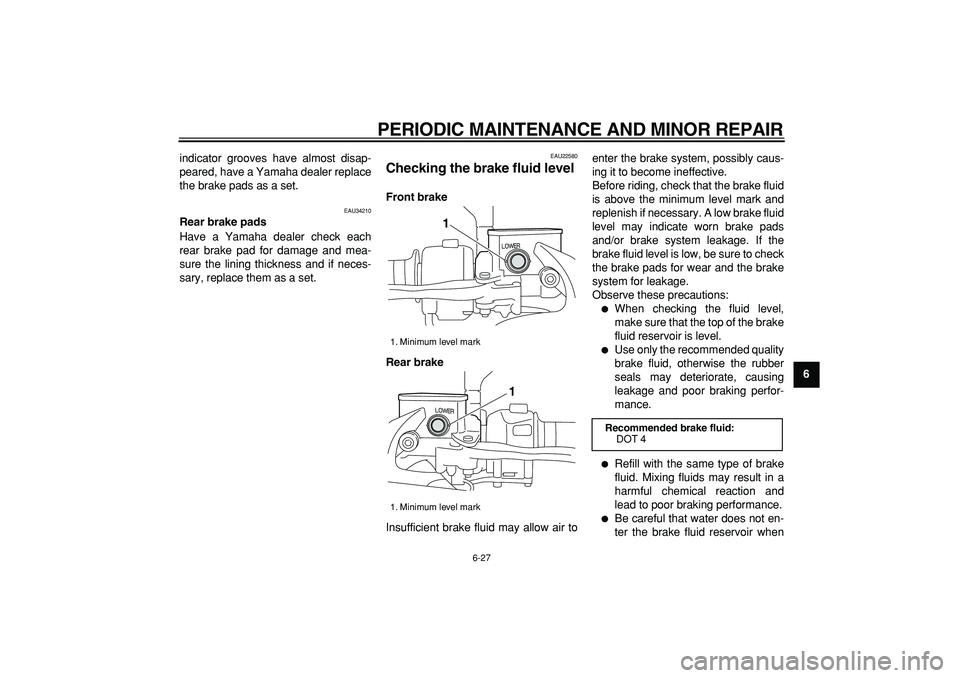Page 66 of 98

PERIODIC MAINTENANCE AND MINOR REPAIR
6-22
1
2
3
4
5
6
7
8
9
EAU21382
Checking the throttle cable
free play
The throttle cable free play should mea-
sure 3.0–5.0 mm (0.12–0.20 in) at the
throttle grip. Periodically check the
throttle cable free play and, if neces-
sary, have a Yamaha dealer adjust it.
EAU21401
Valve clearance
The valve clearance changes with use,
resulting in improper air-fuel mixture
and/or engine noise. To prevent this
from occurring, the valve clearance
must be adjusted by a Yamaha dealer
at the intervals specified in the periodic
maintenance and lubrication chart.
EAU21871
Tires
To maximize the performance, durabil-
ity, and safe operation of your vehicle,
note the following points regarding the
specified tires.
Tire air pressure
The tire air pressure should be checked
and, if necessary, adjusted before each
ride.
WARNING
EWA10500
�
The tire air pressure must be
checked and adjusted on cold
tires (i.e., when the temperature
of the tires equals the ambient
temperature).
�
The tire air pressure must be ad-
justed in accordance with the
riding speed and with the total
weight of rider, passenger, car-
go, and accessories approved
for this model.
1. Throttle cable free play
1
Page 67 of 98

PERIODIC MAINTENANCE AND MINOR REPAIR
6-23
2
3
4
5
67
8
9
WARNING
EWA14660
Because loading has an enormous
impact on the handling, braking,
performance and safety characteris-
tics of your vehicle, you should keep
the following precautions in mind.
�
NEVER OVERLOAD THE VEHI-
CLE! Operation of an overload-
ed vehicle may result in tire
damage, loss of control, or se-
vere injury. Make sure that thetotal weight of rider, passenger,
cargo, and accessories does
not exceed the specified maxi-
mum load for the vehicle.
�
Do not carry along loosely
packed items, which can shift
during a ride.
�
Securely pack the heaviest
items close to the center of the
vehicle and distribute the
weight evenly on both sides.
�
Adjust the suspension and tire
air pressure with regard to the
load.
�
Check the tire condition and air
pressure before each ride.Tire inspection
The tires must be checked before each
ride. If the center tread depth reaches
the specified limit, if the tire has a nail or
glass fragments in it, or if the sidewall is
cracked, have a Yamaha dealer re-
place the tire immediately.
NOTE:
The tire tread depth limits may differ
from country to country. Always comply
with the local regulations.
Tire air pressure (measured on cold
tires):
0–90 kg (0–198 lb):
Front:
200 kPa (29 psi) (2.00 kgf/cm
2
)
Rear:
250 kPa (36 psi) (2.50 kgf/cm
2
)
YP400 90–189 kg (198–417 lb)
YP400A 90–185 kg (198–408 lb):
Front:
200 kPa (29 psi) (2.00 kgf/cm
2
)
Rear:
250 kPa (36 psi) (2.50 kgf/cm
2
)
Maximum load*:
YP400 189 kg (417 lb)
YP400A 185 kg (408 lb)
* Total weight of rider, passenger, car-
go and accessories
1. Tire sidewall
2. Tire tread depth
Minimum tire tread depth (front and
rear):
1.6 mm (0.06 in)
12
Page 68 of 98

PERIODIC MAINTENANCE AND MINOR REPAIR
6-24
1
2
3
4
5
6
7
8
9Tire information
This model is equipped with tubeless
tires.
WARNING
EWA10470
�
Have a Yamaha dealer replace
excessively worn tires. Besides
being illegal, operating the vehi-
cle with excessively worn tires
decreases riding stability and
can lead to loss of control.
�
The replacement of all wheel
and brake related parts, includ-
ing the tires, should be left to a
Yamaha dealer, who has the
necessary professional knowl-
edge and experience.
EAU21992
Cast wheels
To maximize the performance, durabil-
ity, and safe operation of your vehicle,
note the following points regarding the
specified wheels.
�
The wheel rims should be checked
for cracks, bends, warpage or
damage before each ride. If any
damage is found, have a Yamaha
dealer replace the wheel. Do not
attempt even the smallest repair to
the wheel. A deformed or cracked
wheel must be replaced.
�
The wheel should be balanced
whenever either the tire or wheel
has been changed or replaced. An
unbalanced wheel can result in
poor performance, adverse han-
dling characteristics, and a short-
ened tire life.
�
Ride at moderate speeds after
changing a tire since the tire sur-
face must first be “broken in” for it
to develop its optimal characteris-
tics.
�
After repairing or replacing the rear
tire, tighten the valve stem nut and
locknut to the specified torques.
Front tire:
Size:
120/80-14M/C 58S
Manufacturer/model:
IRC/MB67
DUNLOP/D305FL
Rear tire:
Size:
150/70-13M/C 64S
Manufacturer/model:
IRC/MB67
DUNLOP/D305L
Page 69 of 98
PERIODIC MAINTENANCE AND MINOR REPAIR
6-25
2
3
4
5
67
8
9
EAU33453
Front and rear brake lever free
play
Front
Rear
There should be no free play at the
brake lever ends. If there is free play,
have a Yamaha dealer inspect the
brake system.
WARNING
EWA14211
A soft or spongy feeling in the brake
lever can indicate the presence of air
in the hydraulic system. If there is air
in the hydraulic system, have a
Yamaha dealer bleed the system be-
fore operating the vehicle. Air in the
hydraulic system will diminish the
braking performance, which may re-
sult in loss of control and an acci-
dent.
1. Valve stem nut
2. Valve stem locknut
Tightening torques:
Valve stem nut:
2.0 Nm (0.2 m·kgf, 1.4 ft·lbf)
Valve stem locknut:
3.0 Nm (0.3 m·kgf, 2.2 ft·lbf)
1
2
1. Brake lever free play
1. Brake lever free play
1
1
Page 70 of 98

PERIODIC MAINTENANCE AND MINOR REPAIR
6-26
1
2
3
4
5
6
7
8
9
EAU33473
Adjusting the rear brake lock
lever cable
Rear brake lock lever cable adjustment
may be required if the rear brake lock
lever does not hold properly. When the
rear brake lock lever is not in use, the
rear brake lock lever cable length
should measure 45 mm to 47 mm (1.77
in to 1.85 in) at the rear brake caliper.
Periodically check the rear brake lock
lever cable length and, if necessary,
adjust it as follows.
To increase the rear brake lock lever
cable length, turn the adjusting nut at
the rear brake caliper in direction (a).To decrease the rear brake lock lever
cable length, turn the adjusting nut in
direction (b).
WARNING
EWA10650
If proper adjustment cannot be ob-
tained as described, have a Yamaha
dealer make this adjustment.
EAU22390
Checking the front and rear
brake pads
The front and rear brake pads must be
checked for wear at the intervals spec-
ified in the periodic maintenance and
lubrication chart.
EAU22430
Front brake pads
Each front brake pad is provided with
wear indicator grooves, which allow
you to check the brake pad wear with-
out having to disassemble the brake.
To check the brake pad wear, check
the wear indicator grooves. If a brake
pad has worn to the point that the wear
1. Adjusting nut
2. Rear brake lock lever cable length
1
2
(b) (a)
1. Wear indicator groove
11
Page 71 of 98

PERIODIC MAINTENANCE AND MINOR REPAIR
6-27
2
3
4
5
67
8
9
indicator grooves have almost disap-
peared, have a Yamaha dealer replace
the brake pads as a set.
EAU34210
Rear brake pads
Have a Yamaha dealer check each
rear brake pad for damage and mea-
sure the lining thickness and if neces-
sary, replace them as a set.
EAU22580
Checking the brake fluid level
Front brake
Rear brake
Insufficient brake fluid may allow air toenter the brake system, possibly caus-
ing it to become ineffective.
Before riding, check that the brake fluid
is above the minimum level mark and
replenish if necessary. A low brake fluid
level may indicate worn brake pads
and/or brake system leakage. If the
brake fluid level is low, be sure to check
the brake pads for wear and the brake
system for leakage.
Observe these precautions:
�
When checking the fluid level,
make sure that the top of the brake
fluid reservoir is level.
�
Use only the recommended quality
brake fluid, otherwise the rubber
seals may deteriorate, causing
leakage and poor braking perfor-
mance.
�
Refill with the same type of brake
fluid. Mixing fluids may result in a
harmful chemical reaction and
lead to poor braking performance.
�
Be careful that water does not en-
ter the brake fluid reservoir when
1. Minimum level mark
1. Minimum level mark
1
1
Recommended brake fluid:
DOT 4
Page 72 of 98

PERIODIC MAINTENANCE AND MINOR REPAIR
6-28
1
2
3
4
5
6
7
8
9
refilling. Water will significantly
lower the boiling point of the fluid
and may result in vapor lock.
�
Brake fluid may deteriorate paint-
ed surfaces or plastic parts. Al-
ways clean up spilled fluid
immediately.
�
As the brake pads wear, it is nor-
mal for the brake fluid level to grad-
ually go down. However, if the
brake fluid level goes down sud-
denly, have a Yamaha dealer
check the cause.
EAU22730
Changing the brake fluid
Have a Yamaha dealer change the
brake fluid at the intervals specified in
the NOTE after the periodic mainte-
nance and lubrication chart. In addition,
have the oil seals of the master cylin-
ders and calipers as well as the brake
hoses replaced at the intervals listed
below or whenever they are damaged
or leaking.
�
Oil seals: Replace every two
years.
�
Brake hoses: Replace every four
years.
EAU23100
Checking and lubricating the
cables
The operation of all control cables and
the condition of the cables should be
checked before each ride, and the ca-
bles and cable ends should be lubricat-
ed if necessary. If a cable is damaged
or does not move smoothly, have a
Yamaha dealer check or replace it.
WARNING
EWA10720
Damage to the outer sheath may in-
terfere with proper cable operation
and will cause the inner cable to
rust. Replace a damaged cable as
soon as possible to prevent unsafe
conditions.
Recommended lubricant:
Engine oil
Page 73 of 98
PERIODIC MAINTENANCE AND MINOR REPAIR
6-29
2
3
4
5
67
8
9
EAU23111
Checking and lubricating the
throttle grip and cable
The operation of the throttle grip should
be checked before each ride. In addi-
tion, the cable should be lubricated at
the intervals specified in the periodic
maintenance chart.
EAU23172
Lubricating the front and rear
brake levers
The pivoting points of the front and rear
brake levers must be lubricated at the
intervals specified in the periodic main-
tenance and lubrication chart.
EAU23212
Checking and lubricating the
centerstand and sidestand
The operation of the centerstand and
sidestand should be checked before
each ride, and the pivots and met-
al-to-metal contact surfaces should be
lubricated if necessary.
Recommended lubricant:
Silicone grease